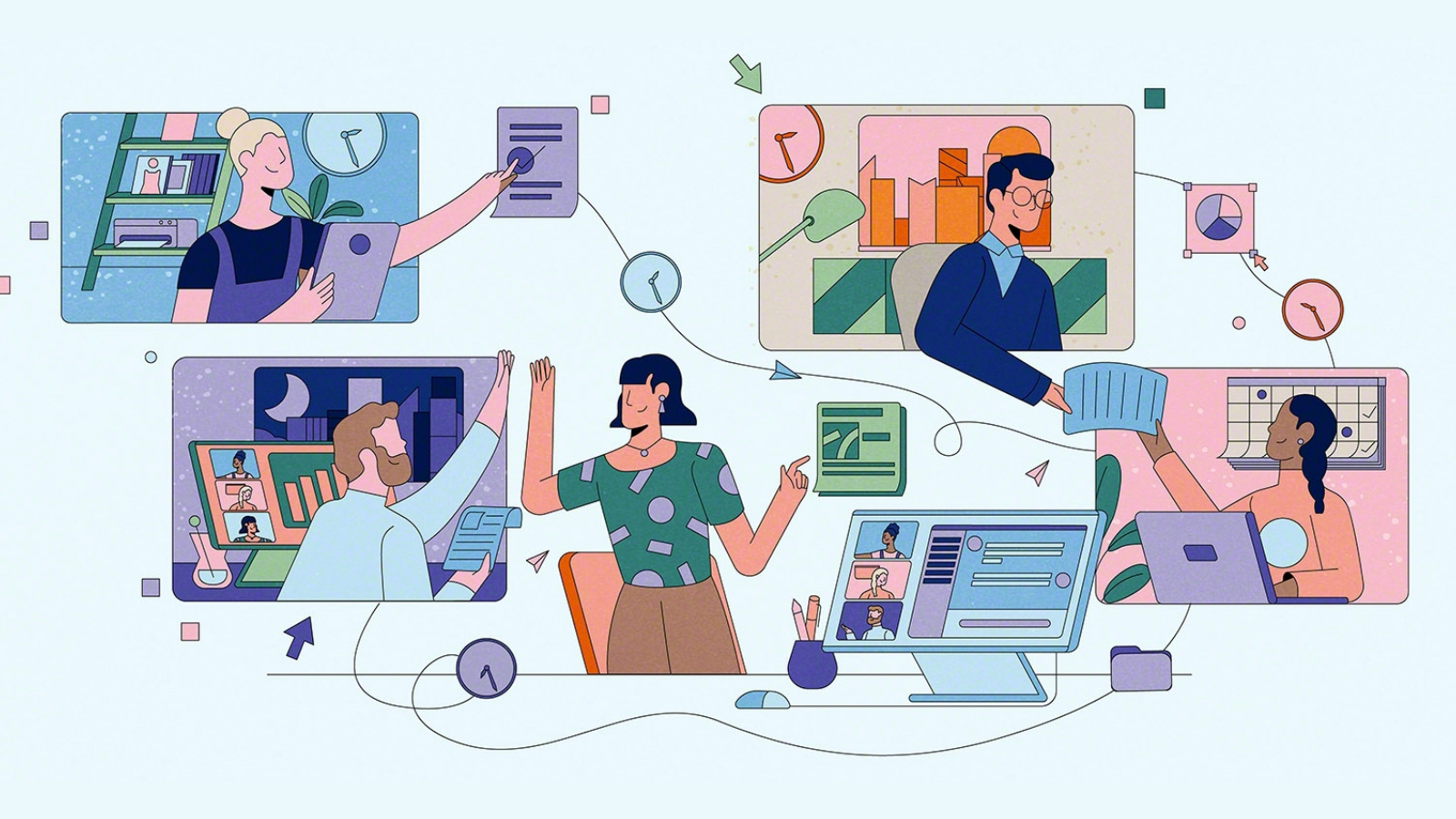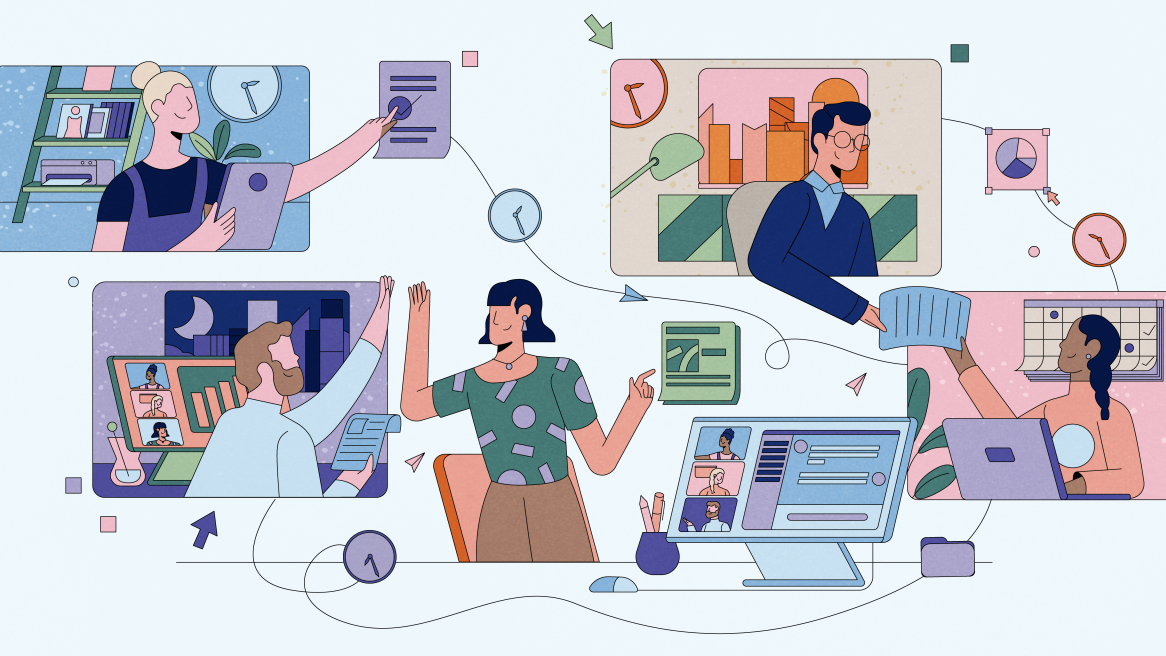
This article is part of our Steelcase 360 series Making Distance Work about working remotely.
“We’ve come to understand that the rhythm of working remotely is not a perfect 9-5 melody. But understanding something can be very different from living it.”
Donna Flynn
Vice President, Steelcase Workspace Futures
People around the world have suddenly found themselves working remotely amid the Coronavirus epidemic. Many are working from home, while others may still be coming to their offices but need to connect with teammates in different locations. For most of us, it’s a brand new experience and it takes some adjusting. Working remotely creates a new set of challenges and behaviors:
How can you stay connected to your team?
How do you create and support a remote culture?
How can we keep the work moving forward?
For several years, I have been leading a global team distributed across multiple time zones and regions of the world and we’ve learned, through experience and experimentation, how to work together when we can’t be together. We’ve come to understand that the rhythm of working remotely is not a perfect 9-5 melody — this is true whether you’re in the same time zone or not. But understanding something can be very different from living it. I’d like to share five team practices we’ve adopted I think can help remote teams manage their new reality:
1. Use collaboration tools based on what you need to do – and constantly search for better ones
The tools available to distributed teams today are good, but not perfect for everything we do. So we use different apps for different purposes – including O365, WhatsApp, Teams, and Mural. We have fully adopted Mural (a digital, highly-visual sticky note canvas) as a team and it has dramatically improved our team’s collaboration when we need to create something together. We’ve tried a lot of video conference platforms and none are perfect. Ideally, we prefer to use Cisco telepresence when all nodes connecting are in an office for its high definition quality and content sharing features, but this is not the most viable tool for connecting from home.
Other web video platforms like Zoom and Microsoft Teams work well as long as you have good bandwidth – but sometimes you still have to choose between seeing the people and seeing the content being shared. We’ve found that it takes a lot of patience and flexibility to use these tools effectively, and adaptability in swapping out tools in the moment as needed – such as dropping an unstable video connection and switching to a conference call because the bandwidth in one place is experiencing latency.
2. Pay extra attention to your colleagues who are on the phone or on video
We talk a lot about the concept of “presence disparity” which means that people who are remote can be at a disadvantage compared to people in the room. For example, people in the same room are more likely to talk to each other and forget about the person on the video screen and the person on the speaker phone. Likewise, it’s easier to enter the conversation as a distributed participant using video than audio only because your visual presence makes it easier to get people’s attention.
We are consistently looking for new ways to solve for this, yet too often our own teams experience a bias for those who are physically present over those who are joining remotely. The most powerful tool for this is awareness. We need to remember to be more inclusive and give everyone the opportunity to contribute to the conversation. Practice eye contact with people on video, gently pause a passionate conversation and ask the more quiet participants to chime in. It also helps to equalize “presence’ by having everyone call into the video conference or conference call individually – which we are seeing now during the COVID-19 crisis.
3. Schedule consistent meetings to help remote team members connect
Serendipitous encounters with colleagues are still limited not only by our current situation but also by our current technologies. We have learned that having consistent meetings where people can connect in both formal and informal ways is critical for fostering team cohesion. Our team has weekly meetings to provide this structure – and we make them long enough to allow for technology connection hiccups, sharing of project work, and some time for catching up on personal news or life stage celebrations like engagements or new babies.
We also hold occasional “Social Hours” and some of my team members are now holding virtual “Studio Hours” where they log into video to have a consistent ‘wormhole’ of connecting with each other even if they are focused on individual work. Every team needs to think about what may be best for them, but you’ll want more of these checkpoints during extreme distribution than you would need for co-located teams.
4. Share the burden of 24/7 across the team
We will never be able to change our human circadian rhythms, even though some of us may be early birds and others night owls. Time separation on a global team presents one of the biggest physical, cognitive and emotional challenges. In the past we used to always default to meeting during the work day in Grand Rapids, Mich. (U.S. Eastern Time) because that is where most people are based and make our Asia team members stay up late.
But we realized that this was creating an imbalance on the team and it wasn’t fair to everyone. So several years ago we started rotating our meeting schedule around the world. Every month, each team member now has one evening, one mid-day, and one early morning meeting, and misses one meeting that falls in the middle of their night. No team member is expected to attend a team meeting between 10 pm and 7 am.
5. Invest in bringing the team together on a regular rhythm to foster team cohesion
I realize this is not an option right now due to COVID-19 travel restrictions, but we’re all learning first hand that no tool can replace being together in the same room. I bring my globally dispersed team together every nine months for team workshops, which have proven invaluable for renewing personal ties, building trust, and having unmediated and embodied experiences together. I have three rules for these workshops: We should build something together, we should learn something together, and we should have plenty of informal, social time.
I also use these times for us to engage in team strategic discussions or decision-making, since it’s much more effective to reach alignment around complex issues when we are in the same room. When we’re able to travel again, I know the costs for these team rituals spurs our team’s performance for the long periods of distribution. A smart travel strategy is a necessary component for a high-performing, globally-integrated team. Think about how you can reignite your team’s bond when this current crisis comes to an end.
All of these approaches add up to increasing our team’s empathy for one another. This compassion fuels trust, engagement and collaboration – and drives our business forward.
Stay in Touch
Sign up to receive a regular email from Steelcase 360. We will keep adding stories, research, insights — anything we’re learning that might be helpful – as well as new story, podcast and magazine releases.
hbspt.forms.create({
portalId: “1822507”,
formId: “af6f600e-c408-4e24-a17d-cd9f12b2b45b”
});



